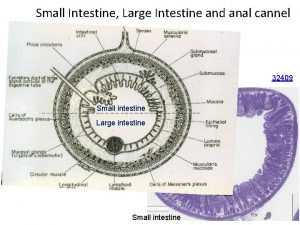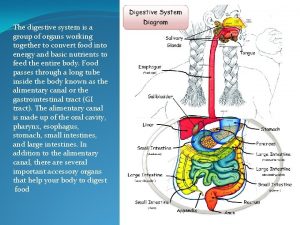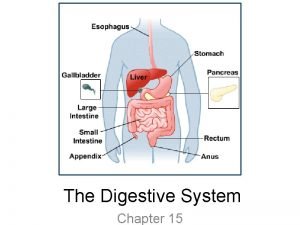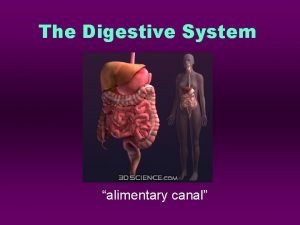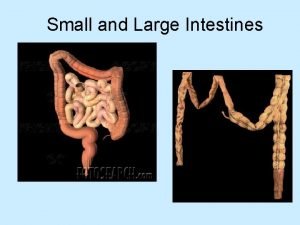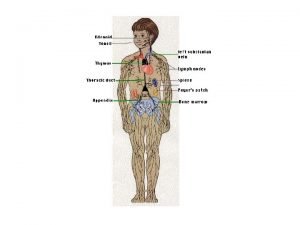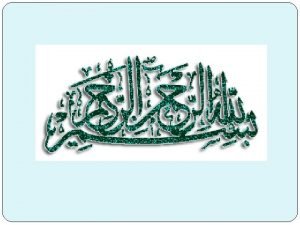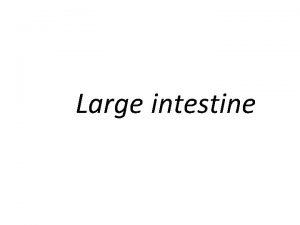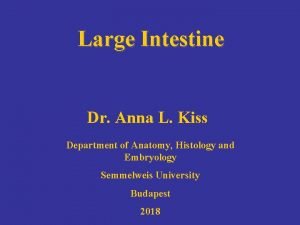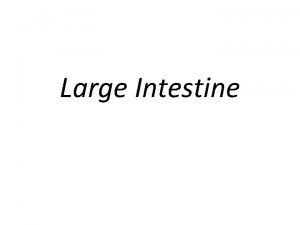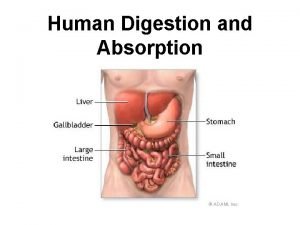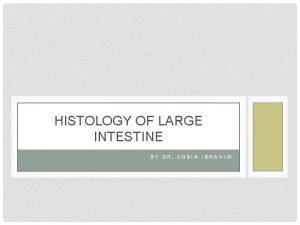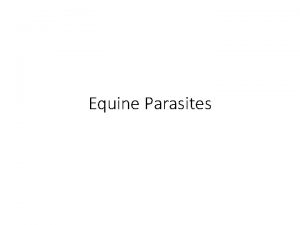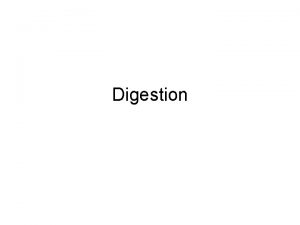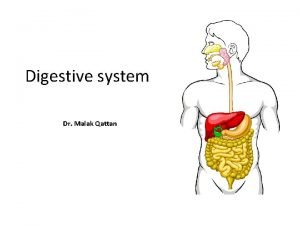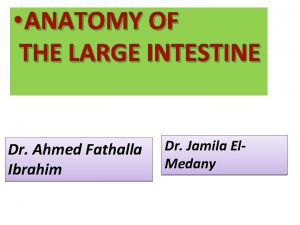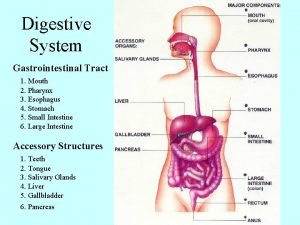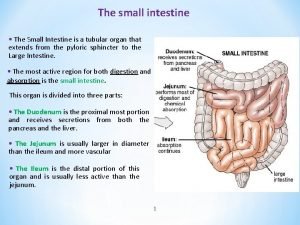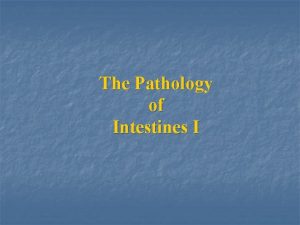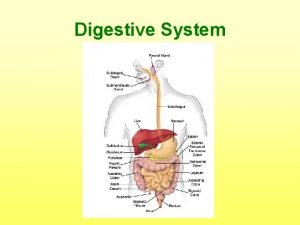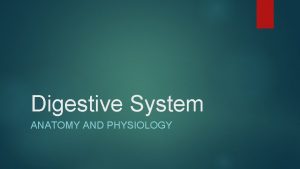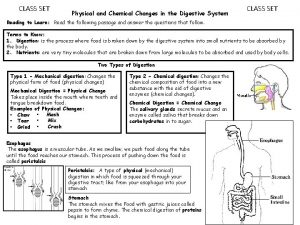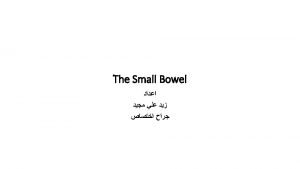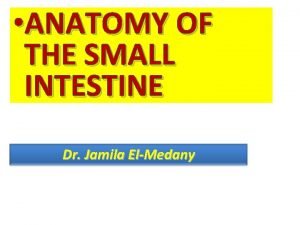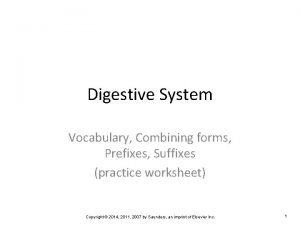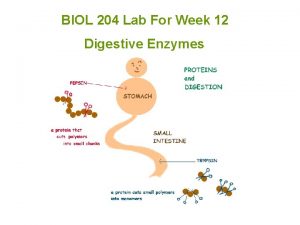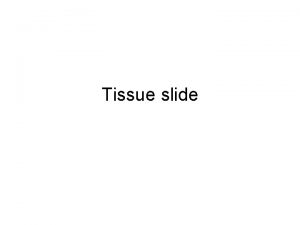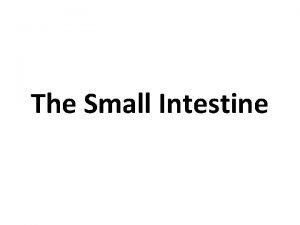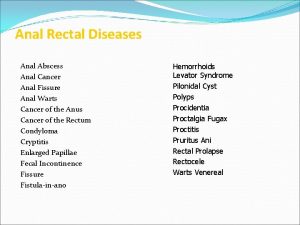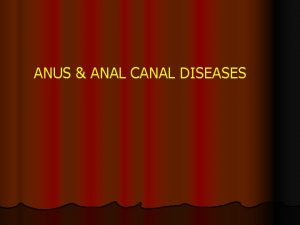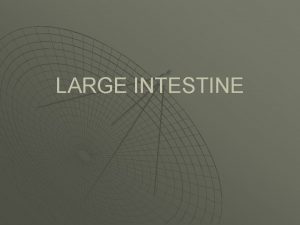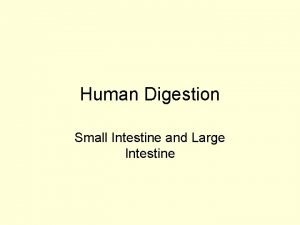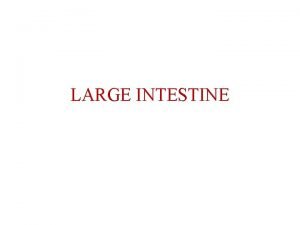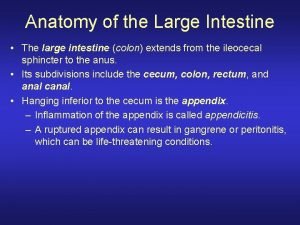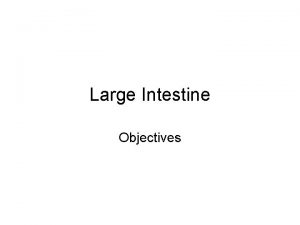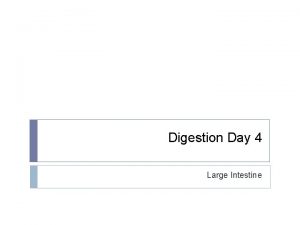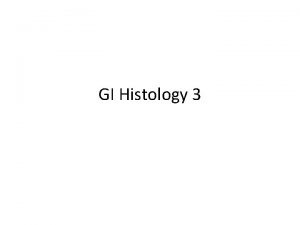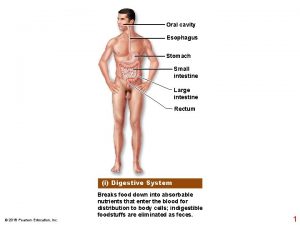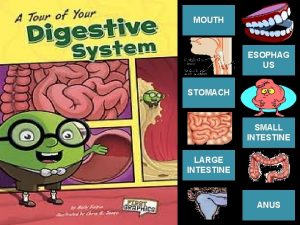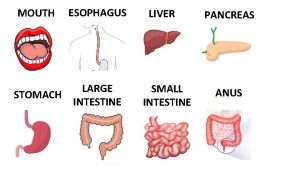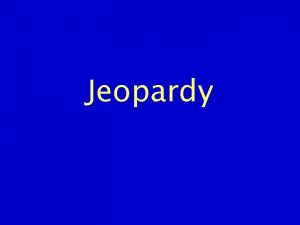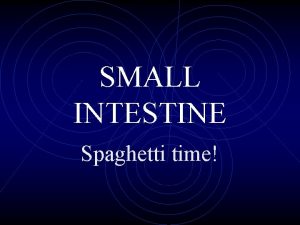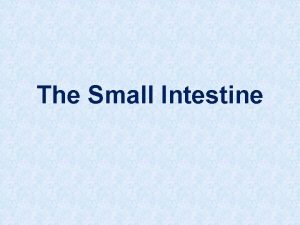Small Intestine Large Intestine and anal cannel 32409







































- Slides: 39

Small Intestine, Large Intestine and anal cannel 32409 Small intestine Large intestine Small intestine

General Structure of the Digestive Tract central lacteal rat 32409 Epithelium with goblet cells and absorptive cells Lamina propria Muscularis mucosa Submucosa Muscularis externa (tunica muscularis) Serosa

Slide #37 (Ed 904‐ 64 b). Small intestine, donkey. Mesothelium of serosa tunica muscularis the myenteric (“Auerbach’s) plexus located between the inner circular and outer longitudinal smooth muscle layers of the tunica muscularis neuronal cell bodies of the submucosal (“Meissner’s) plexus submucosal (Brunner’s) glands intestinal crypts (glands of Lieberkuhn) muscularis mucosa lamina propria central lacteal muscularis mucosa

Slide #37 (Ed 904‐ 64 b). Small intestine, donkey. Intestinal absorptive cells Simple columnar epithelium Paneth cells Goblet cell Paneth cell brush” or “striated” border = High density of non-branching microvilli of uniform length. Microfilaments are the cytoskeleton component in microvilli

Paneth cells Slide #37 (Ed 904‐ 64 b). Small intestine, donkey Absorptive cells Enteroendocrine Cells (EC cells) Mitotic figures

Enteroendocrine cells in fundic stomach, rabbit (toluidine blue) To see the distribution of EC cells among glands 244 Chief cells Parietal cell Enteroendocrine cells

monkey 146 Duodenum, Enteroendocrine cell Crypts of Lieberkühn Goblet and absorptive cells, Muscularis mucosa Lamina propria. Submucosal Brunner's glands.

152 Duodenum Brunner’s glands Absorptive cells Goblet cells Paneth cell Enteroendocrine cell Intestinal villus

Slide #37 (Ed 904‐ 64 b). Small intestine, donkey. Enteroendocrine cells

DEMO SLIDE BOX 57 ‐‐‐ Small intestine (ileum), dog. Goblet cell Intestinal crypts (glands Or Crypts of Lieberkuhn Smooth Muscle in Intestinal villus Peyer’s patches lamina propria of the villi central lacteals

DEMO SLIDE BOX 57 ‐‐‐ Small intestine (ileum), dog. Enteroendocrine cell Intestinal crypts (glands Or Crypts of Lieberkuhn

DEMO SLIDE BOX 225 (C‐‐‐H‐‐‐ 73 ). Small intestine (jejunum), dog. Absorptive cells epithelial Modifications = Brush border and goblet cells central lacteal Strips of Muscularis mucosa lamina subglandularis muscularis mucosa submucosa

DEMOSLIDE BOX 225 (C‐‐‐H‐‐‐ 73 ). Small intestine (jejunum), dog. lamina subglandularis stratum granulosum stratum compactum muscularis mucosa submucosa Enteroendocrine cells Paneth cells lamina subglandularis Absorptive cells

DEMOSLIDE BOX 225 (C‐‐‐H‐‐‐ 73). Small intestine (jejunum), dog. Crypts of Lieberkuhn submucosa tunica muscularis lamina subglandularis muscularis mucosa Submucosal (“Meissner’s”) Smooth muscle cells serosa. Mesothelium of serosa myenteric (“Auerbach’s”) plexuses

Slide #192 (Pf 5‐‐‐ 84 d). Small intestine (jejunum), pig. . submucosa Absorptive cells lamina propria muscularis mucosa tunica muscularis

Slide #192 (Pf 5‐‐‐ 84 d). Small intestine (jejunum), pig. central lacteal Brush border of absorptive cells Intestinal absorptive cells Simple columnar epithelium Smooth muscle cells of the muscularis mucosa lamina propria Goblet cell Paneth cells Enteroendocrine cells

Slide #89 (83 DF 1) – Small intestine, puppy (dog). Epithelium Lamina propria Muscularis mucosa Submucosa tunica muscularis Serosa

Slide #89 (83 DF 1) – Small intestine, puppy (dog). Lymph nodules Intestinal crypts (glands Or Crypts of Lieberkuhn Small intestinal villi central lacteal

Slide #89 (83 DF 1) – Small intestine, puppy (dog). Dividing cells Epithelium Lamina propria myenteric (“Auerbach’s”) plexuses Muscularis mucosa (developing) Submucosa with lymphoid cell infiltration tunica muscularis Serosa mesothelium

Compare luminal surfaces of the small and large intestines small intestines Villi large intestines NO Villi

DEMO SLIDE BOX 167 (C 003‐‐‐H‐‐‐ 29)‐‐‐Large intestine (cecum), dog. villi are absent Epithelium Lamina propria Muscularis mucosa Submucosa tunica muscularis Smooth muscle Serosa Lymph nodules Peyer’s patches Intestinal crypts (glands Or Crypts of Lieberkuhn

DEMO SLIDE BOX 167 (C 003‐‐‐H‐‐‐ 29)‐‐‐Large intestine (cecum), dog. villi are absent Intestinal crypts (glands Or Crypts of Lieberkuhn Epithelium Lamina propria Muscularis mucosa absorptive cells and goblet cells Enteroendocrine cells

DEMO SLIDE BOX 61. Large intestine (colon), cat. Epithelium Lamina propria Muscularis mucosa (developing) Submucosa with lymphoid cell infiltration tunica muscularis Serosa

DEMO SLIDE BOX 61. Large intestine (colon), cat. Intestinal crypts (glands Or Crypts of Lieberkuhn absorptive cells goblet cells Epithelium Lamina propria Muscularis mucosa Submucosa

DEMO SLIDE BOX 171 (E 3‐‐‐H‐‐‐ 38). Large intestine (colon), horse. the taenia coli; a gross thickening of the longitudinal layer of tunica muscularis in the horse. taenia coli Lymph nodules Intestinal crypts (glands Or Crypts of Lieberkuhn


DEMO SLIDE BOX 168 (C 003‐‐‐H‐‐‐ 38)‐‐‐Large intestine (colon), dog. Intestinal crypts (glands Or Crypts of Lieberkuhn Epithelium with goblet cells and absorptive cells Lamina propria Muscularis mucosa Submucosa Muscularis externa (tunica muscularis) Serosa

DEMO SLIDE BOX 168 (C 003‐‐‐H‐‐‐ 38)‐‐‐Large intestine (colon), dog. Enteroendocrine cells Intestinal crypts (glands Or Crypts of Lieberkuhn

Slide #43 (K 9‐‐‐ 1). Anal region, dog. the recto‐‐‐anal junction and regional skin rectum goblet cells located in the crypts rectum nonkeratinized stratified squamous epithelium regional skin circumanal glands (perianal glands) which can become neoplastic

Slide #43 (K 9‐‐‐ 1). Anal region, dog. keratinized stratified squamous epithelium

Slide #43 (K 9‐‐‐ 1). Anal region, dog the circumanal glands (perianal glands) in this region CCT Walled off with CCT parasite external anal sphincter = bundles of skeletal muscle

DEMO SLIDE BOX 62‐‐‐Rectum and anal canal, dog. the circumanal (perianal) glands skin large invagination of the anal sac. rectum simple columnar epithelium

Again the simple columnar epithelium is missing. Note the approximate recto‐‐‐anal junction. At this junction, there is an abrupt change to nonkeratinized stratified squamous epithelium. Near the junction of nonkeratinized and keratinized stratified squamous epithelium, observe the large invagination of the anal sac. The inner circular layer of the tunica muscularis is somewhat thickened to form the internal anal sphincter. The skeletal muscle fibers are part of the external anal sphincter. The anal canal is continuous with the skin of the perineal region (note the change in epithelium to keratinized stratified squamous); see the circumanal (perianal) glands

DEMO SLIDE BOX 62‐‐‐Rectum and anal canal, dog. the circumanal (perianal) glands skeletal muscle fibers are part of the external anal sphincter skin keratinized stratified squamous skin nonkeratinized stratified squamous epithelium rectum tunica muscularis (smooth muscle) is somewhat thickened to form the internal anal sphincter. large invagination of the anal sac. rectum

Large intestine or Colon, monkey

MUCOCUTANEOUS JUNCTIONS

Slide 66: Recto‐anal junction External anal sphincter Internal anal sphincter Anus Rectum

Slide 66 : Recto‐anal junction Keratinized stratified squamous epithelium Hair follicles Sebaceous glands Gland ducts Apocrine glands Anus

Digestive tract distinguishing features human summary Mucosa (epithelium, lamina propria, muscularis mucosa) Submucosa (with submucosal plexuses) Muscularis (Inner circular and outer longitudinal layers, with myenteric plexuses between them) Adventitia/ Serosa Esophagus (upper, middle, lower) Nonkeratinized stratified squamous epithelium; cardiac glands at lower end Small esophageal glands (mainly mucous) Both layers striated muscle in upper region; both layers smooth muscle in lower region; smooth and striated muscle fascicles mingled in middle region Adventitia, except at lower end with serosa Stomach (cardia, fundus, body, pylorus) Surface mucous cells, and gastric pits leading to gastric glands with parietal and chief cells, (in the fundus and body) or to mucous cardiac glands and pyloric glands No distinguishing features Three indistinct layers of smooth muscle (inner oblique, middle circular, and outer longitudinal) Serosa Small intestine (duodenum, jejunum, ileum) Plicae circulares; villi, with enterocytes and goblet cells, and crypts/glands with Paneth cells and stem cells; Peyer patches in ileum Duodenal (Brunner) glands (entirely mucous); possible extensions of Peyer patches in ileum No distinguishing features Mainly serosa Large intestine (cecum, colon, rectum) Intestinal glands with goblet cells and absorptive cells No distinguishing features Outer longitudinal layer separated into three bands, the teniae colo Mainly serosa, with adventitia at rectum Anal canal Stratified squamous epithelium; longitudinal anal columns Venous sinuses Inner circular layer thickened as internal sphincter Adventitia
 Muscularis mucosa
Muscularis mucosa Esophagus stomach small intestine large intestine
Esophagus stomach small intestine large intestine Bicuspids
Bicuspids What organ is responsible for drying out indigestible food
What organ is responsible for drying out indigestible food Haustrum colon
Haustrum colon Rugae
Rugae Small intestine parts
Small intestine parts Lymphoid follicle
Lymphoid follicle Appendices epiploicae
Appendices epiploicae Appendetitis
Appendetitis Labelled diagram of a tooth
Labelled diagram of a tooth Characteristics of water soluble vitamins
Characteristics of water soluble vitamins Plica ileocolica
Plica ileocolica Gross anatomy of the large intestine
Gross anatomy of the large intestine Orange juice ph
Orange juice ph Rectum
Rectum Equine large intestine
Equine large intestine Large intestine function in digestive system
Large intestine function in digestive system The main jobs of the large intestine are _____.
The main jobs of the large intestine are _____. Part of large intestine
Part of large intestine Large intestine function in digestive system
Large intestine function in digestive system Large intestine function
Large intestine function Mash, grind, mix and tear food.
Mash, grind, mix and tear food. Intertubercular plane
Intertubercular plane Pharynx
Pharynx The small intestine extends from the
The small intestine extends from the Small intestine gangrene
Small intestine gangrene Hepatorenal fossa
Hepatorenal fossa Protein digestion begins in the _____.
Protein digestion begins in the _____. Function of duodenum
Function of duodenum Is the small intestine a physical or chemical change
Is the small intestine a physical or chemical change Blood supply small bowel
Blood supply small bowel Small intestine parts
Small intestine parts Ventral dorsal position
Ventral dorsal position Suffix pepsia
Suffix pepsia External anatomy of the frog parts and function
External anatomy of the frog parts and function Small intestine
Small intestine Small intestine
Small intestine Parts of small intestine
Parts of small intestine Small intestine villi function
Small intestine villi function
